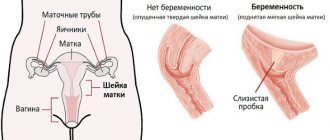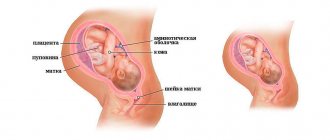False contractions or Braxton Hicks contractions
loading...
This phenomenon got its name for a reason. John Braxton-Hicks is a British physician who was the first to describe this process in a woman’s body in 1872. Such contractions are a short-term contraction of the uterine muscles, observed in women with increased uterine tone.
Such sensations appear after 20 weeks of gestation, or rather, before that the woman simply does not feel them. Hypertonicity of the uterus can manifest itself within 24 hours, but during the day, due to being busy, the expectant mother, as a rule, does not notice short-term contractions lasting up to 2 minutes. The number of false contractions increases with gestation, but the duration remains unchanged.
For normal childbirth, the uterine muscles must be in good shape. During the last month of pregnancy, the cervix may dilate 1-4 centimeters, depending on the number of previous pregnancies. Immediately before childbirth, precursor contractions serve to soften and shorten the cervix.
False or training contractions
False contractions during pregnancy are a phenomenon that raises many questions and doubts, especially among first-time mothers. What do they look like, can they be dangerous, how do training contractions differ from the real ones that will culminate in childbirth? It is not always possible for a woman to get answers to all these questions at a antenatal clinic. Therefore, every woman who is expecting her first child is recommended to attend special courses or lectures for expectant mothers. Self-education will not be amiss: this is exactly what we will do, analyzing in detail this phenomenon - false contractions.
Training contractions - sensations
Braxton Hicks contractions are characterized by the following symptoms:
- a feeling of tightness in the lower abdomen or groin area;
- irregular - less than 6 cases per hour;
- sensations are concentrated in a certain area, and do not “flow” from the abdomen to the lower back, as with real contractions;
- do not cause pain or discomfort;
- gradually disappear completely.
Interesting: Preparing for childbirth. What to take to the maternity hospital?
Regarding pain, it can be noted that as the period increases, the intensity of the discomfort increases. Women with high pain sensitivity can suffer greatly from them.
When should you expect “fake” contractions?
False contractions can occur at any stage of a healthy pregnancy, and this is an absolutely normal and natural process designed to prepare the uterus for childbirth. However, in the early stages they most often are not recorded in any way by the woman’s consciousness, that is, they pass completely painlessly and unnoticed. Training contractions become more obvious after 20 weeks, and by 38 weeks they appear in 70% of women.
Something unusual also happens - a pregnant woman does not encounter such a harbinger of labor as false contractions. Do not be afraid of such a development of events: whether you like it or not, a healthy body is in any case preparing for the birth of a child, even if there are no external signs in the form of cramping tension in the uterus. This is an individual feature of the course of pregnancy, which does not in any way affect the success of childbirth. Perhaps you have a high pain threshold: what brings very sensitive and uncomfortable sensations to another expectant mother happens to you casually. This is neither good nor bad, it’s just that every mother-baby pair is a whole world, and there is no one correct course of pregnancy and childbirth.
What to do and how to benefit from it?
Many expectant mothers note that false contractions occur more often if they do even the simplest physical work. According to doctors and obstetricians, even with the slightest discomfort, you should either lie down, or get up and take a calm walk, changing your occupation. If you have severe anxiety, you can drink some water or calming herbal tea.
Recommendations for minimizing discomfort:
- identify by observation at what time of day and under what conditions discomfort during false contractions increases;
- the provoking factor may be a full bladder;
- orgasm can also provoke too intense training contractions, so after 38 weeks it is recommended to abstain from sex.
To reduce discomfort, you can take the following measures:
- take a warm bath for no more than 10 minutes;
- lie down on your left side;
- take a walk in the fresh air;
- drink a glass of clean water;
- do breathing exercises;
- relax.
Relieving false contractions and reasons to consult a doctor
False contractions are excellent training for the upcoming birth. They help a woman get used to unpleasant sensations and learn to breathe correctly. However, if training contractions of the uterus cause severe discomfort to a woman, there are 5 simple ways to get rid of them:
- Change of body position. When performing any physical activity, you should lie down on the bed. If a woman was resting when contractions appeared, she should get up, try to walk, and do light gymnastics.
- Drink a glass of clean water, juice or weak herbal tea.
- You can go for a walk in the fresh air; an increase in oxygen in the blood provokes the cessation of contractions.
- Take a warm shower or bath. Hot water helps relieve muscle tension.
- Breathing exercises. There are many exercises to relieve uterine tension. The most popular is “dog breathing” - a woman should breathe frequently and quickly at the peak of a contraction; the maximum duration of such “gymnastics” is no more than 40 seconds. There is also a “candle” technique - the expectant mother needs to take a deep breath through her nose and then quickly exhale through her mouth.
When the above methods do not help relieve uterine tension, and the duration and frequency of contractions increases, the woman should go to the maternity hospital. It is better to do this when their ratio becomes 5/45 (duration 45 seconds, interval 5 minutes), since the first stage of labor can last 10-12 hours, the first half of which is more comfortable to spend at home. But if the expectant mother is experiencing severe stress, she should go to the maternity hospital as early as possible to be under the supervision of specialists.

Sometimes the appearance of false or true contractions can be a threat to the unborn child. Causes for concern are:
- scarlet discharge from the vagina (possibility of placental abruption);
- watery vaginal discharge (possibility of water rupture);
- secretion of thick mucus (mucus plug comes off);
- very strong, unbearable pain;
- increased frequency of contractions up to 5 per minute;
- reduction or cessation of the baby’s movements;
- feeling of “expansion” of the perineum.
These symptoms may be normal, but if they occur, you should immediately seek medical help. Usually the signs listed above are harbingers of labor, which means the contractions are true. But during training contractions of the uterus, various complications can occur (premature rupture of amniotic fluid), which requires medical intervention.
Breathing exercises for false contractions
Despite the fact that doctors did not come to a consensus on the advisability of such a phenomenon as training contractions in a woman’s body, it was decided to use it for good. These contractions can be combined with the following breathing exercises:
- “Economy breathing” technique - during a contraction you need to take a slow release and take a full deep breath. After the contraction, repeat again;
- “Doggy style” breathing is similar to a dog’s breathing in hot weather: frequent and shallow. Suitable for the fight itself. But it is not recommended to use this technique for more than 30 seconds; you may feel dizzy;
- The “candle” technique is an alternative to the previous option. Inhale deeply and slowly through your nose, then exhale short and sharply through your mouth.
Interesting: Proper nutrition for a nursing mother
What to do during training contractions
What should an expectant mother do during training contractions, especially if they bother her? Use the following tips:
- Change your body position - squat, turn over, lie on your back. The most important thing is that you feel comfortable.
- Take a short walk around the street or house, moving smoothly and slowly.
- Taking a warm shower is a great way to stop training contractions.
- Go to the toilet, empty your bladder.
- Drink still water and fruit drinks.
- Take a break from contractions - take up your favorite hobby, listen to music or read.
- Just try to ignore false contractions.
Do the following breathing exercises:
- Blow out the candles - inhale deeply through your nose and then exhale through your mouth. You should inhale slowly and exhale sharply and quickly.
- Breathe like a dog - shallow, quick inhalations and exhalations during a contraction. You should not breathe this way for more than 30 seconds to avoid dizziness.
- Save your breath - during a contraction, exhale slowly and then take a deep, full breath. then, after the fight is over, the exercise is repeated.
How to distinguish false contractions from labor ones?
When training contractions begin, expectant mothers are interested not only in how long they last, but also in how to distinguish them from real contractions. It is impossible to confuse them, since prenatal sensations are quite painful and intense. In general, labor pains are very individual in sensations. Some compare them to very severe menstrual pain, others to the sensation of diarrhea. Here are some signs of labor pains starting:
- discomfort and dull pain in the lower abdomen, which is felt every 10 minutes or more than 5 times per hour;
- the presence of regular contractions in the lumbar region;
- increased pressure in the pelvic area or vagina;
- colic that resembles menstrual colic;
- bleeding;
- nausea, vomiting and diarrhea;
- the presence of copious liquid discharge.
How to distinguish contractions from training ones: symptoms
It is not difficult to distinguish false contractions from real ones. But it is difficult to determine this on your own.
Experts recommend that when starting this process at a later date, consult a doctor for advice.
In order to know how to identify real abbreviations from false ones, you must first know what they are for. Training contractions are aimed at stretching the muscles of the uterus for further childbirth.
They increase blood flow to the uterus and promote the transport of oxygen to the unborn baby.
Note! When labor begins, the cervix gradually opens, preparing for the birth of the baby. With false ones, the cervix remains closed. This is the main criterion for determining false or real abbreviations.
It is impossible to independently determine the condition of the cervix, so consultation with a doctor is necessary.

Table: differences between false contractions and real ones
| Criterion | Real contractions | Training contractions |
| Cyclicality | Cyclic interval between contractions. The onset of labor is characterized by the fact that contractions become more frequent and their duration increases over time. | Irregular interval between contractions. If after the first contraction the second does not appear for a long time, then the female body has begun preparing the muscles of the uterus for childbirth. |
| Pain | There is pain. | In most cases, contractions are painless. In rare cases, lower back pain occurs. |
| Neutralization of pain | Painful sensations at the beginning of labor cannot be relieved on your own. This can only be done with the help of painkillers. | If after changing the position of the body the contractions stop, then this is a sign of the occurrence of training contractions. |
Useful video
Share this post
- Related Posts
- Are uterine fibroids dangerous during early pregnancy?
- Antibiotics allowed during pregnancy: 1st trimester
- What herbs can you drink during pregnancy: list?
- Strong prayer to preserve pregnancy and conceive a child
- Tips for early and late pregnancy
- Pills to terminate early pregnancy: list with prices
How long do training contractions last?
The duration of the attacks will also tell you that the alarm turned out to be false. Training contractions last for a short time - from a few seconds to 2 minutes.
It is noteworthy that as the period increases and as labor approaches, false contractions may appear more and more often, but their duration normally never increases. Moreover, it is not at all necessary to feel these uterine contractions: many women do not feel them at all.
If training contractions give you some discomfort, try to distract yourself somehow. Rest or, on the contrary, a leisurely walk can help you. Already now learn to breathe correctly and relax - this will be very useful during childbirth. Listen to your body, try to understand and feel it.
Should I worry?
Be prepared for the fact that closer to childbirth, false contractions may “sink” lower into the pelvis and become more intense - which means you will give birth within 2-4 weeks. Take training contractions calmly, do not get hung up on them. But if they are accompanied by suspicious symptoms, it is better to go to the hospital immediately:
- the uterus turns to stone for more than 2 minutes;
- contractions become regular (more than 4 times per hour);
- contractions are very painful;
- contractions are accompanied by vaginal discharge - clear or bloody;
- Along with the contractions, a nagging pain appeared in the lower back.
If you don’t observe anything like this in yourself, then there is nothing to worry about. The only inconvenience associated with the increase in false contractions in late pregnancy is that it will become increasingly difficult for you to find a comfortable position in bed. But this is facilitated by a large tummy, increased sensitivity and irritability, and many other factors. So we recommend getting a variety of different pads and bolsters so that you can place them wherever you can if necessary. You should not force yourself to fall asleep if this is not possible. Better listen to music or read a book.
Let training contractions be good preparation for childbirth for you, and not an unnecessary cause for concern.
Especially for beremennost.net – Elena Kichak
How to ease contractions?
Although Braxton Hicks training contractions do not cause severe pain, for your own peace of mind and comfort you can relieve them with the following techniques:
- take a comfortable, relaxed position or simply change your body position;
- drink water, eat something light;
- take a warm shower or bath;
- take a walk in the fresh air;
- listen to pleasant, relaxing, meditative music;
- do breathing exercises for training before childbirth.
False contractions not only prepare the body for the birth of a child, but also give a pregnant woman an excellent chance to practice experiencing pain. No matter how alarming this may be to every mother, the birth process is almost always accompanied by pain of varying degrees of intensity. And in this sense, the so-called false contractions are in some way the moment of truth. The ability to relax and experience any sensations will be very useful during childbirth. Different types of breathing help to endure pain without interfering with the opening of the cervix and without slowing down the process. If contractions occur, try breathing in one of the following ways:
- “Dog”: rapid, shallow breathing for several minutes. It is not recommended to use it for too long - you may run out of air and feel dizzy.
- Exhale slowly at the peak of the contraction, take a deep breath. After the contraction ends, continue taking deep breaths and exhalations.
- Inhale slowly through your nose and exhale sharply through your mouth.

Warning symptoms
Pregnancy is not a disease, but it does not always go smoothly. Sometimes false contractions are accompanied by symptoms that require immediate medical attention:
- atypical discharge before labor begins: bloody, watery, mucous;
- severe pain;
- feeling of pressure on the perineum;
- frequency of contractions more than 4 times per minute.
When you know everything about false contractions (why they are needed, how they feel and what they look like, how long training contractions last, how to distinguish them from labor contractions and how to alleviate your condition), you can calmly and confidently experience them without unnecessary worries. This is what we wish for all expectant mothers.
Sources:
https://o-krohe.ru/rody/shvatki/trenirovochnye/ https://www.beremennost-po-nedeliam.com/vedenie-beremennosti/trenirovochnye-sxvatki.html https://kidsman.ru/beremennost/lozhnye -ili-trenirovochnye-sxvatki
Feelings during contractions
What are they, training contractions? Their very name eloquently suggests that this is training before real, productive contractions, which will lead to the dilatation of the cervix and the expulsion of the fetus through the birth canal “into the light of day.” When training contractions begin, the woman feels:
- sensations of rhythmic compression inside the abdomen;
- heaviness and mild soreness;
- petrification in the abdominal area;
- slight discomfort.
Specific phenomena come and go unexpectedly, without any periodicity or systematicity. However, some women note that training contractions more often occur during rest, before bed, or vice versa, at a time when physical activity is present, for example, during a walk or exercise in the pool. False contractions do not cause severe pain. Painful training contractions may indicate pathology, so if they occur before 36-37 weeks, you should consult a doctor for help or advice.

Difference from real contractions
There are signs to determine whether contractions are preparatory or true. The occurrence of real contractions indicates the beginning of the labor process. This significance of contractions does not give some pregnant women peace. But you shouldn’t worry and get ready every time you go to the hospital if you know how to distinguish training contractions from labor contractions.
- Deadlines. False contractions during pregnancy occur periodically from 20 weeks, and real contractions not earlier than 36 weeks, and then during early labor, and normally at 39–40 weeks.
- Regularity and duration. Training contractions occur chaotically, do not increase and quickly pass with a change in activity or on their own. How long do false contractions last? No more than 2 minutes. Labor contractions gradually gain strength and duration, the interval between them inexorably shortens, the pain intensifies: a frequency of 5–6 times per minute means that the woman is in labor.
- Additional signs of childbirth: pain in the lower spine, cleansing of the stomach and intestines (vomiting, diarrhea), discharge of water and mucus plug. False contractions are not accompanied by such symptoms.
- Real contractions cannot be stopped by anything other than special medications. Training contractions before childbirth can not only be eased, but also stopped with the help of antispasmodics (papaverine, no-spa) or a warm bath.
The power of water
Ordinary warm water is a wonderful helper for a pregnant woman. If the expectant mother does not have any pathologies or health problems, a bath at a pleasant temperature will not only do no harm, but will also relax and harmonize her condition.
In addition, water is a reliable and safe indicator of the truth of the contraction process. Take a bath, but not hot or cold, but lukewarm, comfortable for the body, and plunge into it when contractions begin. False contractions will pass within 10 minutes after immersion. But labor pains may subside for a while or weaken slightly, but it will be impossible to reverse them.

This method can be used whenever doubt arises: how to distinguish false contractions from real ones. Couldn't relieve contractions with water? – It’s time to prepare for the trip to the maternity hospital, meeting the baby is very soon.











